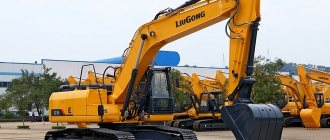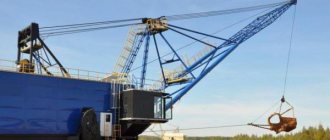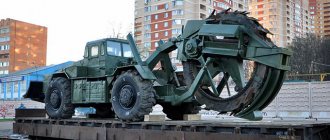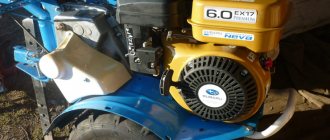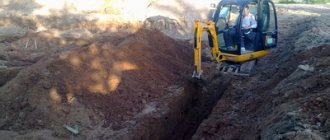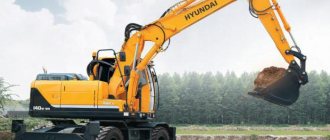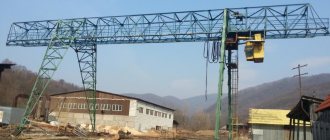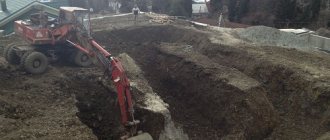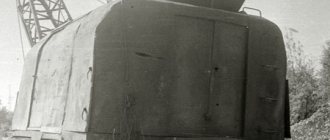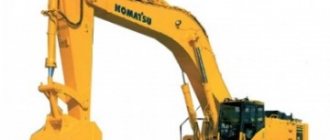Digging a pit for the foundation of a house or trenches for a foundation is the initial stage in any construction, residential or industrial. The strength and durability of the entire future structure depends on how well it is made.
The process of digging a pit with an excavator
The excavation is developed in several stages and is not limited to directly digging a hole, as many people who are far from construction think. This is true for foundations of any type - slab, strip, block. For columnar and screw ones, excavation work using machinery is not carried out.
Soil development methods and types of excavators
The development technology directly depends on the type of special equipment that will be used at the site. Its type is determined at the stage of preparation of project documentation.
Let's consider the features of operating excavators with continuous buckets, as well as models of special equipment with a backhoe, dragline and grab mechanisms.
Special equipment with backhoe
They are in demand when interacting with soil located below the parking level of equipment, as well as when creating pits of insignificant dimensions and trenches with sharp slopes. Special equipment of this type is used in construction, as well as in the creation of hydraulic facilities.
It is possible to rent special equipment in Sochi. Special equipment undergoes regular maintenance. It is possible to rent with or without a driver and for short and long periods.
The development of the soil takes place by digging "on oneself", in which the boom is directed up and down at the time of each scoop. The interaction is carried out frontally or sideways. In the first situation, the excavator passes along the axis of the excavation, simultaneously dumping soil onto equipped dumps or auxiliary vehicles. In a situation with a side face, the shovel goes to the side of the excavation, dumping the contents as it goes.
Working mechanisms of the “dragline” type
It is used when interacting with soils located below the parking level of equipment, in particular, when digging pits, trenches and working with underwater massifs. Models of this type are often used when cleaning slopes and leveling construction sites. An important advantage of draglines is their impressive working radius (up to 10 meters) and significant digging depth (up to 12 meters).
The bucket is suspended on a flexible base, so cross-shuttle and longitudinal-shuttle digging methods become as efficient as possible. The first method involves passing the dump truck to the loading zone along the bottom of the excavation and loading by alternating scooping in both directions relative to the body. The longitudinal shuttle method involves collecting soil from the rear wall of the body and unloading it above the surface of the vehicle.
Operation of grab type excavators
This special equipment is used when digging wells, pits and trenches. Its use is relevant when interacting with massifs located below groundwater. The peculiarity of digging involves achieving a depth less than the parameters established by the project, as a result of which a shortage remains.
Its layer is usually 5-10 cm. It is necessary to prevent overfilling and damage to the soil base. In order to ensure the efficient operation of excavator-grabs, scraper knives are used, which help automate the bottom cleaning process and ensure its maximum accuracy.
Application of continuous action technology
The most common types of special equipment in this segment are longitudinal digging machines, which are in demand when digging trenches. The working mechanism is a bucket rotor or a bucket chain. In this case, slopes are mounted on the rotor buckets, which are filled with soil as they move upward and are emptied when tipping over.
The operation of excavators with a bucket chain is relevant when digging trenches up to 3.5 m deep, and with a working tool in the form of a rotor for digging trenches up to 2.5 m deep. The waste soil is most often sent to a belt conveyor, which transports it to a dump or an auxiliary vehicle. Dumps, as a rule, are located on one side of the excavation.
When and why is digging with special equipment used?
Single-bucket equipment is suitable for all types of soils and rocks. Including high humidity and groundwater inflow. For soils from categories 1 to 4 inclusive, it is recommended to use multi-bucket types of equipment. Although safe operation is permissible only in categories 1 to 3. In the case of 4, manipulations should be carried out only in homogeneous layers.
In order to dig a trench,
a machine is selected after studying the important parameters:
- The need to use replaceable devices.
- Availability and possibility of groundwater inflow.
- Category of cut material.
- Notch characteristics.
If several models are suitable at once, it is recommended to give preference to forward and reverse shovels, or so-called “draglines”.
Maximum filling with minimum time is important to determine the volume for the bucket capacity. The maximum load indicator is directly dependent on the depth of work, the complexity of cutting, and the type of material being processed. Climatic conditions and terrain also influence the final decision.
Excavation of a pit using an excavator
Work of this type can be observed at almost all sites in the areas of industrial and residential construction. Excavation of a foundation pit with an excavator is especially important when carrying out a wide range of construction activities. Depending on the type of special equipment, different digging technologies may be used. Standard development of a foundation pit is carried out in 7 stages:
- Conducting geological examination, site analysis.
- Development of project documentation.
- Selection of optimal special equipment.
- Organizational and preparatory activities.
- Soil development, sequential removal of layers.
- Strengthening or processing the walls of the pit.
- Acceptance of work by the customer.
The excavation of the pit is controlled by surveyors at all stages. Compliance with safety requirements is organized at the site. Excavation work is carried out in full compliance with the requirements of design documentation, which is drawn up on the basis of engineering surveys.
The main stages of excavation work for laying trenches and digging a pit
Such work includes the following stages:
- Preparatory stage. It includes an assessment of the depth and volume of the planned work, calculation of the depth of the trench or pit, as well as practical advice to inexperienced customers on the characteristics of the work and soil, taking into account what object is planned to be installed on the foundation in the future or what communications will be laid in the trenches being dug.
- Cleaning the site area for quick and comfortable work. Naturally, if on the site in the area where the work is being carried out there are remains of old buildings and structures or trees, stumps, remnants of roots or construction debris, then the work is not possible, since there are significant obstacles to it. In this case, of course, manual excavation of the soil will increase the price per 1 m3 slightly, but the final part of the work will be carried out faster and with better quality.
- Checking the availability and transferring, if necessary, existing utilities. Before starting to dig a pit or trench, be sure to check the work area for the presence of laid pipes, metal mesh, reinforced structures, electrical networks, sewerage, water supply and other communications. If there are any, it is worth moving them first so as not to encounter problems after the start of work. During the transfer, by the way, the area of future digging will be loosened, which will greatly facilitate the work.
- Strengthening the internal walls of a dug pit or trench. Performed with the aim of increasing resistance to various types of damage.
- Filling the remaining unclaimed space. It is made using special vibration equipment, which guarantees excellent quality of work and stability in terms of strength and safety.
Standard technological map (TTK)
A typical technological map regulates the process of excavating soil in trenches using a single-bucket excavator during pipeline laying. The provisions of the document are presented in abbreviation. The regulatory framework consists of the following acts:
- SNiP_12-01-2004;
- SNiP_3.02.01-87;
- SNiP_12-04-2002;
- SNiP_3.05.04-85;
- SNiP_12-03-2001;
- SNiP_III-42-80.
The technology for carrying out the work involves obtaining a permit from the State Technical Inspectorate and subsequent organizational and preparatory measures, during which a responsible person is appointed, information boards are installed, a layout base is adopted, and a working draft is obtained with a plan for the pipeline being prepared for laying.
In addition, it is necessary to obtain a working technological map, instruct workers, create access roads and install inventory structures in accordance with the master construction plan.
Next, the machinery and necessary equipment are prepared, workers receive tools and personal protective equipment, places for storing equipment are created, the work area is fenced, communications are provided, the construction site is equipped with alarms and fire-fighting equipment. Only after this is a report drawn up indicating the readiness of the facility for work.
Safe operation techniques during excavation
- Do not install the machine in a work area with a pronounced slope. For installation, choose only level areas - this will prevent the risk of overturning.
- When performing work on the bucket part with a straight shovel in a face with high walls, it is necessary to promptly remove the resulting peaks.
- In weak and moving ground areas, the path of movement of equipment is strengthened by shields laid on the ground.
- Development of Group IV sections with an excavator is carried out using additional equipment - the installation of specialized devices will prevent premature wear of the mechanisms.
- If the work area becomes very wet, production should be stopped until the surface dries.
Before starting the production process, it is necessary to carefully examine the areas for the appearance of cornices and overhangs.
Construction works
In the process of developing a trench, the following construction work is necessary:
- Development of soil, with its subsequent disposal into a dump, until the required trench width is achieved in accordance with the project.
- Digging pits in pipe joint areas.
- Installation of fastening slopes and drainage (if required).
Next, a geodetic breakdown of the trench is carried out in the horizontal and vertical planes; the requirements for the work are regulated by the provisions of SNiP_3.01.03-84 and SNiP_3.02.01-87. Before digging a trench, it is necessary to clear the area, clear trees, uproot stumps, move communications and other necessary work.
It is important to ensure the design slope of the surface by leveling it with a bulldozer - it is possible to move the soil mass and cut off irregularities up to 15 cm high.
What is the price for equipment services?
There are several factors that influence the price of soil development using this equipment:
- Distance between workplace and base.
- The topography of the soil along with its condition.
- Soil characteristics.
- Total scope of work.
The TSN price estimate base is the main document that also determines the cost . The soil group and bucket capacity must be taken into account when determining the results. The larger the bucket size, the larger the size of the equipment itself.
An example of the cost of developing a trench per meter:
| Name of works | Unit | price |
| Compacted crushed stone base manually layer by layer more than 300 mm | M2 | 2200 |
| Compacted crushed stone base by hand up to 300 mm | M2 | 200 |
| Compacted sand base from 300 mm | M2 | 600 |
| Compacted sand base up to 300 mm | M2 | 600 |
| backfilling | M3 | 200 |
| Manual soil development | M3 | 300 |
| Mechanized method | M3 | 300 |
| Site breakdown, coordinates removal | DOT | 400 |
Excavation of soil with an excavator
The scheme for organizing work on digging a trench is established by the project. This technological map discusses the development of soil using an excavator with a backhoe. It occurs in the process of moving equipment along the axis of the trench, while cutting takes place “on its own” with digging below the parking level. The dumps are arranged on one side of the trench at a distance of at least 50 cm from the edge. The developed soil is subsequently removed and can be used for:
- organization of reserve dumps;
- sinus filling;
- backfilling an unclaimed trench.
Soil unsuitable for further use is transported to city landfills.
During development with a single-bucket excavator, the preservation of soil strength is ensured due to the shortfall. Its unintentional excesses are compensated by filling the excavation with identical local soil, which is added to the design level. The degree of compaction should not fall below a coefficient of 0.95.
Types of cars
The simplest single-bucket excavator is a technique designed for various excavation work and manipulations in the construction industry.
There are not many stages in the production cycle of equipment:
- First, the soil layer is cut and the bucket part is filled.
- The filled bucket is raised to move unhindered to the dumping site.
- The boom is raised to the unloading area. Sometimes lifting the bucket is performed simultaneously with this operation.
- The cut rock is poured out.
- The bucket part is fed again to repeat the loading.
Running equipment ensures the advancement of equipment. itself is divided into several types:
- Rail-walking. With reduced surface pressure and increased maneuverability.
- Walking. It is stable and the pressure on the surface is also minimal.
- Pneumatic.
- Crawler. Provides increased cross-country ability. Suitable for working with difficult terrain.
From the entire production cycle, up to 15-30% of the working time is spent on cutting the rock and collecting it. Therefore, multi-bucket types are considered more productive. Several buckets of different widths ensure continuity of the work process. But there are restrictions related to the dimensions of the rock being lifted. Single-bucket technology works without such restrictions.
There are also rotary and chain excavators:
- Rotary are units with strictly parallel digging. The rotor itself rotates parallel to the axis of the trench.
- Chain varieties are also named after the main working element with which the equipment is supplied. Usually the main body is the frame on which additional equipment is hung.
Over time, mini excavators appeared. Nowadays this technique can be found almost everywhere due to its versatility. The devices cope with different fillings weighing up to 1 ton.
A mini-excavator is usually called a smaller version of standard equipment. An excellent option for small volumes of work and cramped conditions.
Another type of equipment is front loaders. Details of how this type of equipment works in the video:
Calculation of trench dimensions
The trench dimensions are calculated in accordance with the requirements for laying the pipeline. So, with a pipe diameter of 1 meter and an excavation depth of 3 meters, the width of the trench will be about 2 meters (external diameter of the pipe + 1 meter), and in the case of an excavation depth of more than 3 meters, 20 cm is added to the width of the trench for each additional meter of depth .
When the trench is located below the base of the embankment, its profile can have a trapezoidal, rectangular or mixed shape, depending on the hydrogeological state of the area. In stable soil without excess moisture, it is possible to dig channels with vertical walls without securing them. The depth will directly depend on the established soil type:
- Bulk sandy, gravelly - maximum 1 meter.
- Sandy loam, loamy – up to 1.25 meters.
- Clayey – up to 1.5 meters.
When excavating soil to significant depths, it is worthwhile to ensure a trapezoidal wall profile. In any case, it is calculated at the design stage, taking into account all established engineering surveys.
Increasing efficiency indicators during excavation
To increase productivity when carrying out excavation work, you must be guided by certain provisions:
- Calculate the digging radius, taking into account the maximum values of the equipment being used. It should not be higher than 0.7-0.9 of the largest radius of the model used.
- Combine operations to reduce production cycle time. For example, combine the rotation of the platform with the lifting of the bucket part, which is moved to the place for unloading.
- Reduce the rotation angle of the platform by bringing the transport installation site closer to the trench axis. This will help reduce the loss of working time spent turning the platform.
- Equip unloading paths, ensuring rapid movement for removal of lifted material.
- Reduce the time spent moving the excavator by planning and equipping the movement paths.
- If possible, avoid moving machines under their own power, preventing premature wear of the running gear.
- Select a bucket taking into account the rock being cut. For example, use special buckets or bucket containers of at least 1 m3 for loosened rock layers, and use containers from 0.5 to 0.8 m3 for finely crushed rock materials.
- Monitor the ratio of the carrying capacity, the distance for removal and the volume of the bucket container.
How to properly dig a trench with slopes?
Slopes or strengthening of walls is necessary when interacting with wet soil. If fastenings are not provided for by the project, then the steepness of the slopes must correspond to the following parameters:
| Soil type | Slope steepness at maximum depth | |
| No more than 3 meters | More than 3 meters | |
| Sand and fill soil | 1:1.25 | 1:1.5 |
| Sandy loam | 1:0.67 | 1:1 |
| Loam | 1:0.67 | 1:075 |
| Clay | 1:0.5 | 1:0.67 |
Correctly digging a trench with slopes is possible only if the requirements of the project are met. So, for excavations with a depth of more than 3 meters, it is necessary to carry out fastening according to an individual plan. It is also important to consider the possibility of pulling the pipe along the trench and the humidity level. The type of actual fastening depends on the latter.
Features of work acceptance
Quality control of earthworks is carried out on the basis of SNiP 3.02.01-87, 12-01-2004, 3.05.04-86 and III-42-80. The assessment is carried out by specialists or authorized services that have the necessary resources, tools, qualified personnel and technical equipment.
The work involves incoming control of documentation, materials and the quality of the activities performed. In addition, individual processes are assessed and accepted under inspection. The identified characteristics are recorded in a logbook, which is created and maintained in accordance with the provisions of GOST 24297-87.
Operational control involves checking the following aspects:
- the correctness of the transfer of the trench axis, its compliance with the location established by the project;
- bottom profile with depth measurement and setting the location of marks, as well as width measurement;
- slopes according to the design soil structure;
- thickness of the layer of bedding and powders;
- layers of backfill and embankment of the pipe;
- changes in the resulting radii of curvature at turning sections.
Acceptance inspection requires random or complete inspection by the customer and can be carried out at any stage of the work progress. Its results are necessarily entered into the general journal. After completion of trench digging, the customer inspects the object and ensures documentation of the procedure with the preparation of relevant acts with an as-built geodetic diagram and laboratory reports.
Video: correct development, digging a trench with slopes using an excavator for a pipeline.
